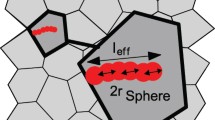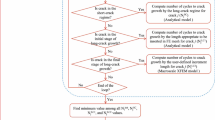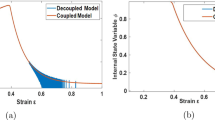Abstract
Fatigue is an important mechanism for the failure of components in many engineering applications and a significant proportion of the fatigue life is spent in the crack initiation phase. Although a large number of research work addresses fatigue life and fatigue crack growth, the problem of modeling crack initiation remains a major challenge in the scientific and engineering community. In the present work, a micromechanical model is developed and applied to study fatigue crack initiation. In particular, the effect of different hardening mechanisms on fatigue crack initiation is investigated. To accomplish this, a model describing the evolution of the particular dislocation structures observed under cyclic plastic deformation is implemented and applied on randomly generated representative microstructures to investigate fatigue crack initiation. Finally, a method is presented to calculate the S-N curve for the polycrystalline materials. With this work, it is demonstrated how the micromechanical modeling can support the understanding of damage and failure mechanisms occurring during fatigue.







Similar content being viewed by others
References
H. Mughrabi: Microstructural fatigue mechanisms: Cyclic slip irreversibility, crack initiation, non-linear elastic damage analysis. Int. J. Fatigue 57, 2–8 (2013).
K.J. Miller: The short crack problem. Fatigue Fract. Eng. Mater. Struct. 5 (3), 223–232 (1982).
K. Tokaji, T. Ogawa, Y. Harada, and Z. Ando: Limitations of linear elastic fracture mechanics in respect of small fatigue cracks and microstructure. Fatigue Fract. Eng. Mater. Struct. 9 (1), 1–14 (1986).
H-J. Christ and H. Mughrabi: Cyclic stress-strain response and microstructure under variable amplitube loading. Fatigue Fract. Eng. Mater. Struct. 19 (2–3), 335–348 (1996).
K.J. Miller: The three thresholds for fatigue crack propagation. In Fatigue and Fracture Mechanics, Vol. 27, Robert S. Piascik, James C. Newman, Jr., and Norman E. Dowling, eds. (ASTM International, Conshohocken, Pennsylvania, 1997), pp. 267–286.
C. Bathias and P.C. Paris: Gigacycle Fatigue in Mechanical Practice, Vol. 185 (CRC Press, Boca Raton, Florida, 2004).
H. Mughrabi: On the life-controlling microstructural fatigue mechanisms in ductile metals and alloys in the gigacycle regime. Fatigue Fract. Eng. Mater. Struct. 22 (7), 633–641 (1999).
H. Mughrabi: On multi-stage fatigue life diagrams and the relevant life-controlling mechanisms in ultrahigh-cycle fatigue. Fatigue Fract. Eng. Mater. Struct. 25 (8–9), 755–764 (2002).
D.L. McDowell, K. Gall, M.F. Horstemeyer, and J. Fan: Microstructure-based fatigue modeling of cast A356-T6 alloy. Eng. Fract. Mech. 70 (1), 49–80 (2003).
D.L. McDowell: Multiaxial small fatigue crack growth in metals. Int. J. Fatigue 19 (93), 127–135 (1997).
J. Lankford and F.N. Kusenberger: Initiation of fatigue cracks in 4340 steel. Metall. Trans. 4 (2), 553–559 (1973).
H. Mughrabi: Cyclic slip irreversibilities and the evolution of fatigue damage. Metall. Mater. Trans. B 40 (4), 431–453 (2009).
K. Tokaji and T. Ogawa: The growth behaviour of microstructurally small fatigue cracks in metals. Short Fatigue Cracks, ESIS 13, 85–99 (1992).
S. Suresh: Fatigue of Materials (Cambridge University Press, Cambridge, United Kingdom, 1998).
V. Bennett and D.L. McDowell: Polycrystal orientation effects on microslip and mixed-mode behavior of microstructurally small cracks. In Mixed-mode Crack Behavior, K.J. Miller and D.L. McDowell, eds. (ASTM International, Conshohocken, Pennsylvania 1999), pp. 203–228.
I. Simonovski, K-F. Nilsson, and L. Cizelj: The influence of crystallographic orientation on crack tip displacements of microstructurally small, kinked crack crossing the grain boundary. Comput. Mater. Sci. 39 (4), 817–828 (2007).
S. Groh and H.M. Zbib: Advances in discrete dislocations dynamics and multiscale modeling. J. Eng. Mater. Technol. 131 (4), 41209 (2009).
B. Künkler, O. Düber, P. Köster, U. Krupp, C-P. Fritzen, and H-J. Christ: Modelling of short crack propagation—Transition from stage I to stage II. Eng. Fract. Mech. 75 (3), 715–725 (2008).
H. Mughbrabi, F.U. Ackermann, and K. Herz: Persistent slipbands in fatigued face-centered and body-centered cubic metals. In Fatigue Mechanisms, Jeffrey T. Fong, ed. (ASTM, Philadelphia, Pennsylvania 1979), pp. 69–95.
R. Wang and H. Mughrabi: Secondary cyclic hardening in fatigued copper monocrystals and polycrystals. Mater. Sci. Eng. 63 (2), 147–163 (1984).
G.M. Castelluccio: A Study on the Influence of Microstructure on Small Fatigue Cracks. PhD thesis, George W. Woodruff School of Mechanical Engineering, Georigia Institute of Technology, Atlanta, Georgia, 2012.
M.A.M. Sharaf: The Microstructure Influence on Fatigue Life Variability in Structural Steels. PhD thesis. RWTH Aachen University, Aachen, Germany, 2015.
D.L. McDowell and F.P.E. Dunne: Microstructure-sensitive computational modeling of fatigue crack formation. Int. J. Fatigue 32 (9), 1521–1542 (2010).
F.P.E. Dunne, A.J. Wilkinson, and R. Allen: Experimental and computational studies of low cycle fatigue crack nucleation in a polycrystal. Int. J. Plast. 23 (2), 273–295 (2007).
C.P. Przybyla and D.L. McDowell: Microstructure-sensitive extreme value probabilities for high cycle fatigue of {Ni}-base superalloy {IN100}. Int. J. Plast. 26 (3), 372–394 (2010).
U. Krupp, O. Düber, H-J. Christ, B. Künkler, A. Schick, and C-P. Fritzen: Application of the EBSD technique to describe the initiation and growth behaviour of microstructurally short fatigue cracks in a duplex steel. J. Microsc. 213 (3), 313–320 (2004).
K. Tanaka and T. Mura: A dislocation model for fatigue crack initiation. J. Appl. Mech. 48 (1), 97–103 (1981).
M. Boeff: Micromechanical modelling of fatigue crack initiation and growth. PhD thesis, Department of Mechanical Engineering, Ruhr Universität Bochum, Bochum, Germany, 2016.
E. Kröner: Allgemeine Kontinuumstheorie der Versetzungen und Eigenspannungen. Arch. Ration. Mech. Anal. 4 (1), 273–334 (1959).
E.H. Lee and D.T. Liu: Finite-strain elastic–plastic theory with application to plane-wave analysis. J. Appl. Phys. 38 (1), 19–27 (1967).
E.H. Lee: Elastic–plastic deformation at finite strains. J. Appl. Mech. 36 (1), 1–6 (1969).
J. Bonet and R.D. Wood: Nonlinear Continuum Mechanics for Finite Element Analysis (Cambridge University Press, 2008).
A. Koester, A. Ma, and A. Hartmaier: Atomistically informed crystal plasticity model for body-centered cubic iron. Acta Mater. 60 (9), 3894–3901 (2012).
F. Roters, P. Eisenlohr, L. Hantcherli, D.D. Tjahjanto, T.R. Bieler, and D. Raabe: Overview of constitutive laws, kinematics, homogenization and multiscale methods in crystal plasticity finite-element modeling: Theory, experiments, applications. Acta Mater. 58 (4), 1152–1211 (2010).
J.R. Rice: Inelastic constitutive relations for solids: An internal-variable theory and its application to metal plasticity. J. Mech. Phys. Solids 19 (6), 433–455 (1971).
J.W. Hutchinson: Bounds and self-consistent estimates for creep of polycrystalline materials. Proc. R. Soc. London, Ser. A 348 (1652), 101–127 (1976).
H. Mughrabi: The long-range internal stress field in the dislocation wall structure of persistent slip bands. Phys. Status Solidi 104 (1), 107–120 (1987).
T. Mayama and K. Sasaki: Investigation of subsequent viscoplastic deformation of austenitic stainless steel subjected to cyclic preloading. Int. J. Plast. 22 (2), 374–390 (2006).
P. Evrard, I. Alvarez-Armas, V. Aubin, and S. Degallaix: Polycrystalline modeling of the cyclic hardening/softening behavior of an austenitic-ferritic stainless steel. Mech. Mater. 42 (4), 395–404 (2010).
P. Evrard, V. Aubin, S. Degallaix, and D. Kondo: Formulation of a new single crystal law for modeling the cyclic softening. Mech. Res. Commun. 35 (8), 589–594 (2008).
A. Manonukul and F.P.E. Dunne: High-and low-cycle fatigue crack initiation using polycrystal plasticity. Proc. R. Soc. London, Ser. A 460 (2047), 1881–1903 (2004).
M. Boeff, F. Gutknecht, P.S. Engels, A. Ma, and A. Hartmaier: Formulation of nonlocal damage models based on spectral methods for application to complex microstructures. Eng. Fract. Mech. 147, 373–387 (2015).
Sandia National Laboratories, CUBIT 13.2., 2013.
K. Inal, J.L. Lebrun, and M. Belassel: Second-order stresses and strains in heterogeneous steels: Self-consistent modeling and X-ray diffraction analysis. Metall. Mater. Trans. A 35 (8), 2361–2369 (2004).
S. Mahmoody: Micromechanical Modeling of Dual-Phase Steel Using a Rate-Dependet Crystal Plasticity Model (McGill University, Montreal, Canada, 2007).
Author information
Authors and Affiliations
Corresponding author
Rights and permissions
About this article
Cite this article
Boeff, M., ul Hassan, H. & Hartmaier, A. Micromechanical modeling of fatigue crack initiation in polycrystals. Journal of Materials Research 32, 4375–4386 (2017). https://doi.org/10.1557/jmr.2017.384
Received:
Accepted:
Published:
Issue Date:
DOI: https://doi.org/10.1557/jmr.2017.384




